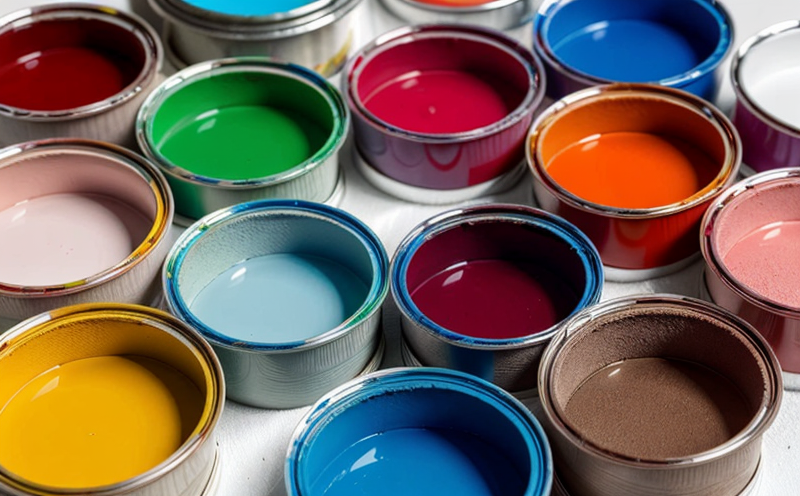EN 71-3 Migration of Hazardous Elements in Lacquers
The European Standard EN 71-3 is a critical guideline for ensuring that toys and related products are safe for children. Specifically, EN 71-3: Safety of Toys — Part 3: Migration of Certain Elements addresses the potential migration of hazardous elements from various materials used in toy manufacturing, including lacquers.
This service ensures compliance with this standard by rigorously testing lacquers for the migration of harmful elements. The test focuses on elements such as lead, cadmium, chromium, and mercury, which can be particularly dangerous if ingested by children due to their potential to cause severe health issues including developmental damage.
The importance of this service cannot be overstated, especially given that lacquers are often used in the coating of toys. Any release of hazardous elements from these coatings could pose significant risks to young users. Our laboratory adheres strictly to the specified methodology and international standards to ensure accurate and reliable results.
Our testing process involves multiple steps to comprehensively evaluate the lacquer’s safety:
- The lacquers are first subjected to rigorous preconditioning, where they undergo specific temperature and humidity conditions to simulate real-world usage scenarios.
- Following this, a standardized extraction solution is applied to each specimen. This step simulates potential contact with children's skin or ingestion pathways.
- The extracted materials are then analyzed for the presence of hazardous elements using state-of-the-art analytical instruments such as ICP-MS (Inductively Coupled Plasma Mass Spectrometry).
Our team of experienced chemists and engineers meticulously interpret the results to determine if any element levels exceed the permissible limits set forth in EN 71-3. Compliance with this standard is mandatory for all toys sold within the European Union, ensuring that children's safety remains our top priority.
| Lacquer Sample Preparation | Extraction Solution Application | Analytical Techniques |
|---|---|---|
| The lacquers are preconditioned under specific temperature and humidity conditions. | A standardized extraction solution is applied to simulate contact with children's skin or ingestion pathways. | ICP-MS is used for precise measurement of hazardous elements. |
In summary, our EN 71-3 service provides a comprehensive approach to evaluating the safety of lacquers used in toy manufacturing. By adhering strictly to this standard and using advanced analytical techniques, we ensure that your products meet all necessary regulatory requirements, thereby protecting children's health and well-being.
Why It Matters
The migration of hazardous elements from lacquers used in toy manufacturing is a critical concern due to the potential risks these elements pose to young users. Children often put toys into their mouths or have prolonged skin contact, increasing the likelihood of exposure to harmful substances.
- Lead: Exposure to lead can cause severe neurological damage and developmental delays in children.
- Cadmium: This element is toxic and has been linked to kidney disease and cancer if ingested or inhaled over time.
- Chromium: Chromium VI compounds are known carcinogens, posing significant health risks.
- Mercury: Mercury exposure can lead to severe neurological disorders and developmental impairments.
The European Union’s stringent regulations under EN 71-3 aim to minimize these risks by setting strict limits on the migration of such elements from toys and related products. Compliance with this standard not only ensures product safety but also protects your brand's reputation and market access within the EU.
By ensuring that your lacquers meet the stringent requirements outlined in EN 71-3, you demonstrate a commitment to child safety and regulatory compliance. This can significantly enhance consumer trust and potentially expand your market reach into Europe and other regions with similar standards.
Scope and Methodology
| Lacquer Sample Preparation | Extraction Solution Application | Analytical Techniques |
|---|---|---|
| The lacquers are preconditioned under specific temperature and humidity conditions. | A standardized extraction solution is applied to simulate contact with children's skin or ingestion pathways. | ICP-MS is used for precise measurement of hazardous elements. |
The scope of this service encompasses the testing of lacquers for the migration of harmful elements as defined in EN 71-3. This includes lead, cadmium, chromium, and mercury, among others. The methodology involves several key steps:
- Sample Preparation: Lacquer samples are carefully selected to represent typical coatings used in toy manufacturing.
- Extraction: A standardized extraction solution is applied to simulate real-world conditions of contact with children’s skin or ingestion pathways.
- Analysis: The extracted materials are analyzed using ICP-MS for precise measurement and identification of hazardous elements present.
The results from these tests help determine whether the lacquers meet the specified limits set by EN 71-3. Our laboratory ensures that all testing is conducted in compliance with this standard, providing accurate and reliable data to support your product safety initiatives.
International Acceptance and Recognition
- European Union: Compliance with EN 71-3 is mandatory for toys sold within the EU. It ensures that all products meet stringent safety requirements, protecting children's health and well-being.
- Australia/New Zealand: The Australian Standard AS/NZS ISO 8124:2018 also includes similar provisions to ensure toy safety, aligning with EN 71-3 for lacquer testing.
Beyond these regions, many countries adopt standards that are harmonized with or derived from international norms such as ISO and ASTM. This ensures a high level of product safety across different markets, reflecting the global commitment to child health and well-being.
The acceptance and recognition of this standard extend beyond regulatory compliance; it also enhances brand reputation and market access. By adhering to EN 71-3, you demonstrate your commitment to quality and safety, which can significantly influence consumer trust and market expansion.





